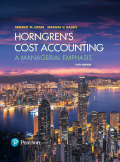
Alternative allocation bases for a professional services firm. The Walliston Group (WG) provides tax advice to multinational firms. WG charges clients for (a) direct professional time (at an hourly rate) and (b) support services (at 30% of the direct professional costs billed). The three professionals in WG and their rates per professional hour are as follows:
| Professional | Billing Rate per Hour |
| Max Walliston | $640 |
| Alexa Boutin | 220 |
| Jacob Abbington | 100 |
WG has just prepared the May 2017 bills for two clients. The hours of professional time spent on each client are as follows:
| Hours per Client | ||
| Professional | San Antonio Dominion | Amsterdam Enterprises |
| Walliston | 26 | 4 |
| Boutin | 5 | 14 |
| Abbington | 39 | 52 |
| Total | 70 | 70 |
- 1. What amounts did WG bill to San Antonio Dominion and Amsterdam Enterprises for May 2017?
Required
- 2. Suppose support services were billed at $75 per professional labor-hour (instead of 30% of professional labor costs). How would this change affect the amounts WG billed to the two clients for May 2017? Comment on the differences between the amounts billed in requirements 1 and 2.
- 3. How would you determine whether professional labor costs or professional labor-hours is the more appropriate allocation base for WG’s support services?
Trending nowThis is a popular solution!
Learn your wayIncludes step-by-step video

Chapter 5 Solutions
EBK HORNGREN'S COST ACCOUNTING
Additional Business Textbook Solutions
Financial Accounting (12th Edition) (What's New in Accounting)
Financial Accounting, Student Value Edition (5th Edition)
Principles of Economics (MindTap Course List)
Fundamentals of Management (10th Edition)
Horngren's Accounting (12th Edition)
Corporate Finance (4th Edition) (Pearson Series in Finance) - Standalone book
- A company must place an order for a product that will be sold in the upcoming holiday season by July 1, 2024 to receive a bulk discount. The demand for the product is forecasted to be 2,500, 4,500, 7,000, or 9,000 units. Leftover units can be sold to a clearance store for $50 per unit. The company purchases the product for $165 and sells it for $250. What is the profit if the company purchases 7,000 units but the actual demand turns out to be 4,500 units? Need answerarrow_forwardWhat is the estimated cost of common equity using the CAPM model of this financial accounting question?arrow_forwardFinancial Accountingarrow_forward
 Cornerstones of Cost Management (Cornerstones Ser...AccountingISBN:9781305970663Author:Don R. Hansen, Maryanne M. MowenPublisher:Cengage LearningPrinciples of Accounting Volume 2AccountingISBN:9781947172609Author:OpenStaxPublisher:OpenStax College
Cornerstones of Cost Management (Cornerstones Ser...AccountingISBN:9781305970663Author:Don R. Hansen, Maryanne M. MowenPublisher:Cengage LearningPrinciples of Accounting Volume 2AccountingISBN:9781947172609Author:OpenStaxPublisher:OpenStax College Managerial Accounting: The Cornerstone of Busines...AccountingISBN:9781337115773Author:Maryanne M. Mowen, Don R. Hansen, Dan L. HeitgerPublisher:Cengage Learning
Managerial Accounting: The Cornerstone of Busines...AccountingISBN:9781337115773Author:Maryanne M. Mowen, Don R. Hansen, Dan L. HeitgerPublisher:Cengage Learning Financial Reporting, Financial Statement Analysis...FinanceISBN:9781285190907Author:James M. Wahlen, Stephen P. Baginski, Mark BradshawPublisher:Cengage Learning
Financial Reporting, Financial Statement Analysis...FinanceISBN:9781285190907Author:James M. Wahlen, Stephen P. Baginski, Mark BradshawPublisher:Cengage Learning





